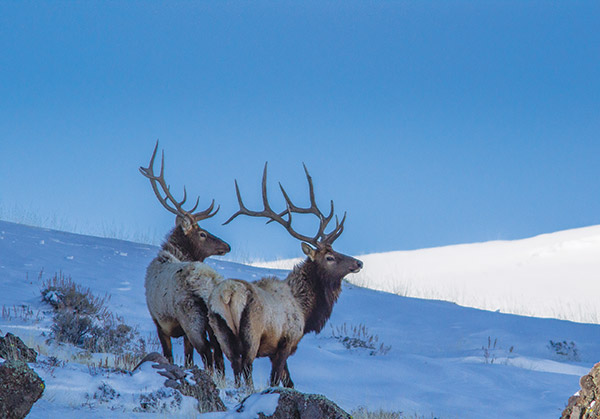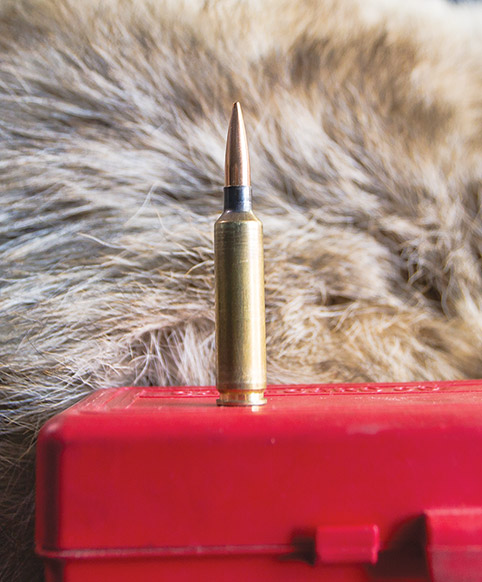 Guns & Ammo: Choosing Hunting Bullets
Guns & Ammo: Choosing Hunting Bullets
By Garhart Stephenson

Very Low Drag bullets are among the sleekest in the shooting world, designed from base to nose to optimize aerodynamic performance. Everything about a VLD bullet says that it means business.
Of course, it’s important to keep in mind just what that business might be. We have bullets designed for nearly every task imaginable, yet no one has figured out a design that does it all.
Target shooting; hunting varmints, small game, big game and fur are all significantly different. For that matter, there are significant differences between fox and coyotes, pronghorn antelope and moose. The short list of considerations for a hunting bullet includes not just effective accuracy range but behavior upon impact and knockdown power. To start at the beginning, lets first discuss accuracy since a bullet is not much use at all but the closest range if it doesn’t fly straight.
This may come as a surprise to some, but the most naturally accurate shape is a round ball. A perfectly round object, due to its uniformity of shape and aerodynamic resistance, exhibits a drag profile that never changes. Turn it anyway you like, and it’s still round. A round ball also transfers energy best (more on that later). However, a ball does not retain velocity or resist wind deflection well, and that is why all but black-powder traditionalists shoot bullets, instead.
Transition from a ball to a “bullet,” and you get a projectile that requires rotational spin to stabilize it in flight. While rifled slugs in smoothbores take a different approach, bullets require a rifled bore to impart the spin that stabilizes them in flight. All else being equal, a shorter bullet is easier to stabilize than a long one. Bullets with more bearing surface (the parallel portion of the bullet that maintains contact with the bore rifling) are also easier to stabilize, and bullets with more aerodynamic drag tend to stabilize quicker. Shorter bullets require a slower twist rate and bullets with a long, sleek profile—like the VLD—require a faster twist rate. It’s all about the shape.
A traditional round-nose bullet can be a superb choice for most hunting. The right loads are easy to stabilize in a wide range of guns. They are just plain forgiving. On the other end of the spectrum, by virtue of length, low drag, and minimal bearing surface, the VLD is rather picky.
That said, the higher ballistic coefficient of a VLD maintains velocity to flatten trajectory and resist wind deflection. With the right rifling twist and load, a speeding VLD bullet can also maintain superb accuracy at extended distances.
A streamlined bullet moving at high velocity buys the long-range hunter a bigger margin for error in other ways, too. Unless the precise distance to the target is known, range estimation can be a challenge. In real-world hunting situations, there isn’t always time to use a laser range finder. Even using a high-tech scope with instant built-in laser ranging, holding a little (or a lot) off for expected wind deflection is an educated guessing game and is where a hunter needs to know his limits. Wind always varies to some degree in speed and direction between the muzzle and intended target.
Then there is human error. An expert marksman can reduce this, especially shooting off of a rest. But no one is perfect, and in hunting situations, a steady hold is not always assured.
A VLD bullet that is moving really fast can negate much of this, but the key when hunting is knowing what actually matters and what does not. Unlike a round-nose bullet at more modest range, a VLD is not a long-range jack of all trades (though some premium offerings do come close). The supreme question is: Will the bullet make a clean one-shot kill at that range?
Anyone hunting big game inside of 300 yards can use a plain old round-nose bullet. The premium flat-base spitzer bullets also work very well at “normal” distances and do bump the range a bit. Boat-tail bullets start showing advantages beyond 300 yards but might not be as accurate as flat-base bullets at distances less than that. An awful lot of 100- and 200-yard benchrest matches are won with flat-base bullets.
Boattails also have a reputation for “spitting their core” when impacting large game. Thankfully, manufacturers have learned to build some reliable controlled-expansion versions, especially helpful in windy country. Yet bullet selection remains a bit of a juggling act.

The VLD shines out past 400 yards, especially in wind. VLD bullets were initially designed for 600- and 1,000-yard target competition. This is where fussing to find the best load for the rifle, to get the best accuracy at such distances, can also pay off.
When it comes to hunting, the VLD can be a best pick for predators and varmints beyond 400 yards or in difficult wind. My .243 Ackley is set up for small critters under such conditions. I don’t use it often, but when I need the beast, it’s a nice option. It sure helped when I promised to eradicate a prairie dog colony on a friend’s windy farm.
But as much as the gun impresses with 95-grain VLD match bullets, I would never use that combination for big game. The bullets were not designed to stop bigger animals. I have watched other hunters try, often with sorry results. Working at the far end of one’s ability and the accuracy potential of the equipment is not advisable. Too many things can go wrong. When the tradeoff is between maximum range and humane kills, I consider that a no-brainer.
Same as a round ball is inherently stable, it also provides maximum energy transfer by virtue of the widest possible cross section without becoming a disc that would act more like a rudder upon penetration. This is why all but “dangerous game” bullets that must penetrate every time are designed to expand on impact.
When a bullet expands on impact, the shape is transformed to better mimic a round ball. A round nose is almost a ball, already, and a soft round nose naturally “mushrooms” on impact.
The VLD bullet is a different story.
It would be asking an awful lot of a long, super-pointy bullet to go through such a radical change without at least partially breaking apart, considering the infinitesimally short amount of time and distance allowed after it pierces the hide and enters the meat of the animal, or worse yet strikes bone.
This is one reason bullets intended for big game, especially dangerous game, are constructed with less radical profiles. It’s just easier to build a bullet that will penetrate and hold together when it only needs to change shape a little bit.
But the times they are a-changing, and some manufacturers are offering longer, sleeker bullets that do absolutely amazing things, like mushroom properly and remain a single, cohesive projectile in the process. They are not cheap, but if a hunter anticipates long shots in open country with high wind (common out West), such bullets are worth every penny. Maximizing range is all about anticipating conditions and then honestly appraising one’s own shooting ability under pressure in hunting situations.
Small game, such as rabbits and tree squirrels, are different than big game or prairie dogs. They aren’t that hard to kill, and minimizing meat damage is a good thing. This is why so many rabbit and squirrel hunters stick with a .22 rimfire and a slow-moving round-nose bullet; it does a good job cleanly harvesting small, edible animals while leaving most of the meat intact. Of course, there is more than one way to skin a cat, or in this case harvest a bunny.
When I was a young hunter, a friend of my dad’s, a member of the Rosebud Sioux, used to take me rabbit hunting. I always brought my tried and true .22 LR. He brought a .243, which was also his deer rifle. The man was endowed with a great set of eyes and was a superb marksman with that familiar rifle. A 200- or even 300-yard shot was nothing special for him, and every cottontail was hit in the head, leaving the succulent portions intact.
His skill and abilities were far above mine. As my skills improved, I adopted his ways with a .17 Ackley Bee single-shot rifle, which was also my fur gun.
The difference with furbearers is that minimal pelt damage is the prime concern rather than saving meat. With smaller varmints like prairie dogs and ground squirrels, the primary concern is safety and instantaneous kills. Happily, this can be achieved with the same rifle shooting bullets that fragment after impact. The one caveat is larger furbearers. The projectile must penetrate sufficiently before fragmenting in order to consistently drop such animals.
Some fragmenting bullets literally blow apart barely under the skin. I was fortunate enough to recover one such coyote when it ran across the trail the following day and I shot it again with a different gun. Imagine my surprise to find the bullet fragments from the previous day under the skin when I peeled the hide that evening. The wound was fresh, and my tire tracks were the only ones in remote, snowy country. So I am pretty sure it wasn’t another hunter’s bullet.
But the worst was a once-popular varmint hollow point in a .204 Ruger. That high-speed pill would zip 80 percent of the way through a coyote and then explode like a grenade as it exited. This left a gaping 6-inch exit hole to try to sew up, and coyotes frequently required a second shot even with ideal bullet placement because the bullet might not expand until after it passed through the lungs. I dropped that had one after ventilating 10 coyotes over the course of a few days.
I have done much better with coyotes using plastic-tipped bullets designed to break apart, especially in .22 centerfires. I tried a variety of .17 bullets before settling on a certain match bullet that is not made anymore. Fortunately, I stocked up.
During a recent outing at a prairie dog town, my .17 Mink performed exceptionally well with 20-grain plastic-tipped bullets. They delivered the goods with exceptional accuracy, and ricochets and the threat of bullets carrying downrange after striking a prairie dog were greatly abated. This made the job easier, and my friend who owned the farm appreciated that, as well.
Before writing this column I discussed much of this with Steve Zihn, a gunsmith, retired Marine Corp shooter and former chief ballistician and later CEO for the Cast Performance Bullet company. Steve has devoted much of his life to a serious study of ballistics, and he has also put in time as an elk guide.
A lot can be learned seeking out such experienced individuals. Hunting guides see firsthand which bullets do the best job, on a regular basis. An experienced fur harvester can usually point you in the right direction in that realm.
Never hesitate to ask for advice from someone with more experience. Most enjoy sharing what they know.
